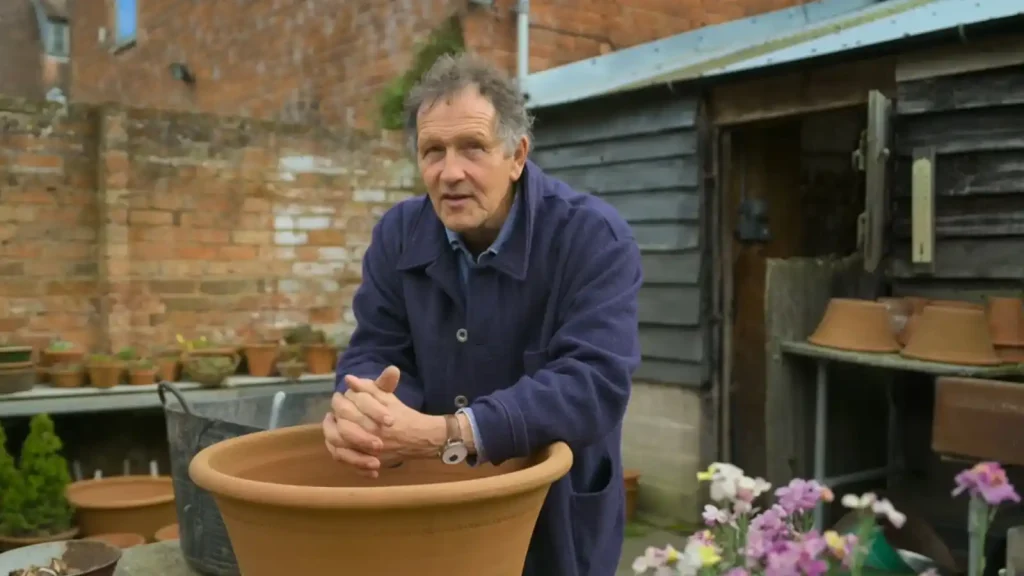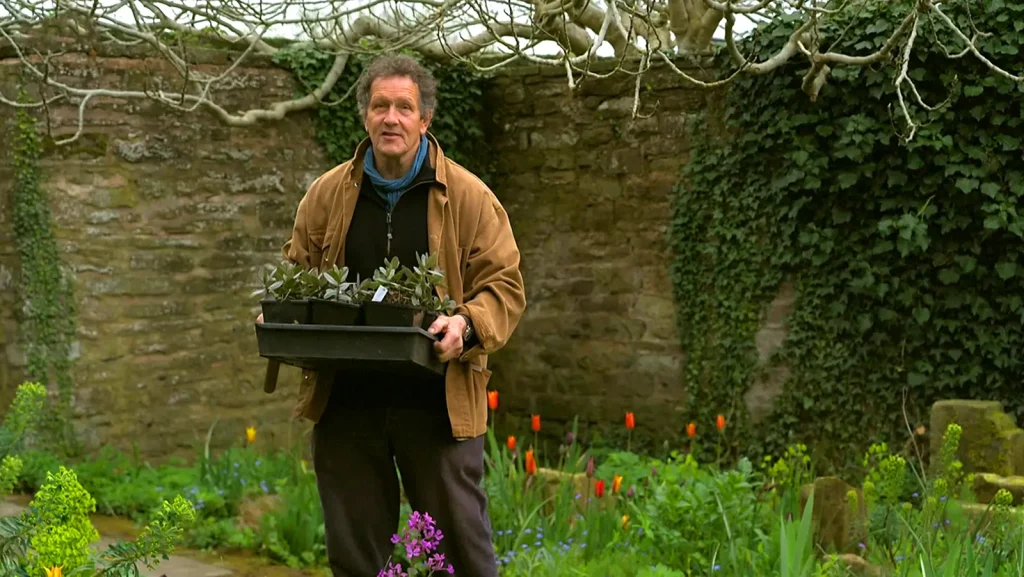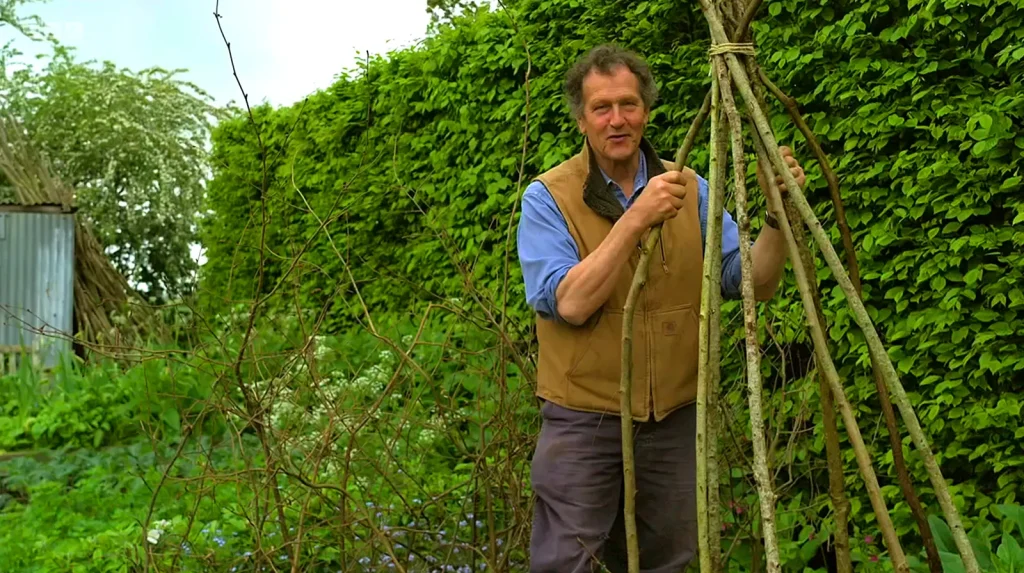Gardeners World 2024 Episode 32: As the golden hues of autumn blanket the landscape, there’s a certain magic in the air that only this season can bring. In Episode 32 of Gardeners’ World 2024, our beloved host Monty Don takes us on a journey through the wonders of fall gardening, sharing wisdom that’s as comforting as a warm cup of tea on a crisp morning.
Monty begins in his orchard, where he plants a hawthorn hedge. This isn’t just any hedge; it’s a living tapestry that will not only provide a natural boundary but also become a haven for wildlife. “Planting a hedge is like writing a love letter to future generations,” Monty muses, his hands gently patting the soil around the young plants. He knows that the hawthorn will flourish, offering blossoms in the spring and berries in the autumn—a gift that keeps on giving.
Transitioning to his climbing roses, Monty demonstrates the art of pruning. With secateurs in hand, he explains, “Pruning is like giving your plants a fresh haircut—it revitalizes them and encourages new growth.” His tips are practical and easy to follow, ensuring that even novice gardeners can tend to their roses with confidence. He emphasizes the importance of removing dead or diseased wood and shaping the plant to allow sunlight to penetrate, fostering a healthier rose bush.
As the days grow shorter, Monty turns his attention to tulips. He starts planting bulbs for next spring, reminding us that gardening is an act of faith in the future. “Each bulb is a promise of beauty to come,” he says, placing them carefully into the rich earth. He offers advice on selecting varieties and planting depths, ensuring that when spring arrives, a vibrant display of colors will burst forth in the garden.
But autumn isn’t just about planting; it’s also about preparation. Monty shares his method for storing dahlia tubers over the winter. Gently lifting them from the ground, he cleans off the excess soil and places them in crates filled with dry compost. “Think of it as tucking them into bed for a long winter’s nap,” he chuckles. This simple act protects the tubers from frost and ensures they’ll be ready to replant when the warmth returns.
Monty also provides timely advice on protecting plants during the colder months. He discusses mulching, covering delicate species, and the importance of good drainage to prevent root rot. “Winter can be harsh, but with a little care, your garden can weather the storm,” he assures us.
Meanwhile, Arit Anderson takes us to a nursery in East Sussex that specializes in hardy perennials and ornamental grasses. Walking among the swaying grasses, she describes them as “the dancers of the garden,” bringing movement and texture to any landscape. The nursery owner shares insights on selecting the best varieties for different soil types and climates, highlighting how these plants can create year-round interest.
Back in another part of the country, Sue Kent meets a gardener who has radically transformed the topography of her plot. Through sheer determination and creativity, she has turned a once-flat space into an immersive garden filled with vibrant colors and varied elevations. “Gardening is about dreaming big and not being afraid to reshape the world around you,” Sue remarks, inspired by the gardener’s bold vision.
In the heart of central London, we discover a community garden that has become a beacon of hope and learning for local residents. This green oasis amidst the urban jungle offers a place for people to connect, grow their own food, and learn about sustainability. “It’s more than just a garden; it’s a community rooted in the soil,” says one of the volunteers. The garden demonstrates how even small spaces can have a significant impact when cultivated with care and shared purpose.
Up in Hawick, in the Scottish Borders, a couple shares their fascination with moss. They delve into the mysteries of these tiny plants, which often go unnoticed underfoot. “Moss is like the whisper of the forest, soft and subtle yet full of life,” they explain. Their garden is a testament to the beauty of mosses, showcasing different varieties that create a lush, emerald carpet. They offer tips on cultivating moss and highlight its ecological benefits, such as retaining moisture and providing habitats for small creatures.
Gardeners World 2024 Episode 32
Throughout the episode, various gardening topics are woven into the narrative. We learn about dahlia care, ensuring these showy flowers continue to brighten our gardens year after year. Tips on getting the best from ornamental grasses are shared, emphasizing how they can add structure and movement. A quick guide to rose pruning simplifies what can seem like a daunting task, breaking it down into manageable steps.
For those considering adding a hedge to their garden, advice on choosing the right type is provided. “A hedge isn’t just a barrier; it’s a living wall that can offer privacy, beauty, and wildlife habitat,” Monty explains. He discusses factors like growth rate, maintenance, and suitability for different environments.
Tulips also take center stage, with insights into selecting varieties for both garden beds and containers. “Tulips are the jewels of the spring garden,” says Monty, encouraging viewers to experiment with colors and forms to create stunning displays. He offers practical advice on planting techniques to ensure a bountiful bloom.
The episode doesn’t shy away from the less glamorous tasks of gardening, either. Guidance on what to do with fallen leaves turns a chore into an opportunity. Monty suggests using leaves to make leaf mold, a valuable soil conditioner. “Think of it as turning nature’s leftovers into garden gold,” he quips.
As the episode draws to a close, we’re left with a renewed appreciation for the changing seasons and the continuous cycle of growth in our gardens. The stories and advice shared remind us that gardening is not just about plants; it’s about connection—to the earth, to each other, and to ourselves.
So as you step into your garden this autumn, remember that every seed you plant and every bulb you bury is a gesture of hope. Let the whispers of the moss and the dance of the grasses inspire you. Embrace the season’s tasks with joy, knowing that your efforts now will blossom into beauty in the months to come.
How to Grow Dahlias: A Comprehensive Guide
Learn how to grow dahlias successfully with our detailed guide covering everything from choosing varieties to planting, care, and overwintering these stunning flowers.
Understanding Dahlias
What Are Dahlias?
We recognize dahlias as tender perennials originating from Central America and Mexico. They grow from underground tubers, with top growth that dies back in winter and re-sprouts in spring. Due to their sensitivity to freezing temperatures, dahlias require protection over winter, especially in colder regions.
The Importance of Tubers
Tubers are swollen, underground parts of the stem or root that store food for the plant. They contain buds capable of producing new plants. Examples include tuberous begonias, cyclamen, dahlias, and potatoes. In milder parts of the UK, tubers may survive outdoors if covered with insulating mulch; otherwise, they should be stored in a frost-free place.
Choosing the Right Dahlias
Variety of Colors and Sizes
Dahlias offer a vast range of flower colors, shapes, and sizes, making selection largely a matter of personal preference. They have been bred extensively, resulting in thousands of cultivars with flowers ranging from vibrant hues to soft pastels and sizes from 5cm (2in) to 30cm (1ft) across.
Factors to Consider
- Plant Height: Shorter varieties (up to 60cm or 2ft) are ideal for containers and front borders. Most dahlias grow to about 1.2m (4ft) and require staking, while some exceed 2m (6.5ft).
- Leaf Color: Darker-leaved cultivars can offer striking visual contrast.
- Flower Type: Single flowers are best for pollinators. Large “dinner-plate” flowers are eye-catching but may not blend well in borders.
- Growing from Seed: An economical way to produce a large display.
Purchasing Dahlias
Available Forms
- Potted Plants: Available in summer, often flowering and ready for immediate planting.
- Dormant Tubers and Rooted Cuttings: Sold from early to late spring. Rooted cuttings are offered by specialist nurseries.
- Seeds: Smaller bedding dahlias are available as seeds and are quick to grow, flowering within a few months.
Considerations for Purchase
When buying tubers or cuttings, remember they typically need a frost-free environment to start growing. Pre-ordering from nurseries can provide a wider selection.
Planting Dahlias
Ideal Planting Location
We recommend planting dahlias in warm, sheltered, sunny spots with rich, fertile, and well-drained soil. They dislike very dry conditions and may rot in waterlogged soil. Ensure ample space between plants—at least 60cm (2ft)—to accommodate their growth.
When to Plant
- Stored Tubers: Best planted in containers in spring and kept indoors until the risk of frost has passed, usually late May or early to mid-June.
- Direct Planting: If space is limited indoors, tubers can be planted directly outdoors in mid to late April.
- Seeds: Sow in early to mid-spring in a propagator.
Planting Techniques
- Indoor Planting: Start dormant tubers or rooted cuttings in pots with multipurpose compost. Keep them frost-free and well-watered.
- Outdoor Planting: Acclimatize plants before transplanting. Prepare the soil with organic matter and a general-purpose fertilizer. Plant at the same depth as they were in their containers.
Caring for Dahlias
Watering Needs
Dahlias are thirsty plants. We advise regular watering during dry and hot weather. Container-grown dahlias require consistent moisture throughout the growing season.
Feeding Recommendations
- Apply a granular general-purpose fertilizer at planting.
- From early July to early September, feed fortnightly with a potassium-rich liquid fertilizer, such as tomato feed.
Supporting the Plants
Due to their top-heavy nature when flowering, dahlias generally need support:
- Large-Flowered Varieties: Use stout stakes and tie stems as they grow.
- Smaller Varieties: Bamboo canes suffice, placed around the clump with twine looped around.
- Dwarf Varieties: Typically do not require staking.
Deadheading for Prolonged Bloom
Regular deadheading encourages more flowers. Remove spent flowers by cutting back to a leaf joint lower on the stem.
Overwintering Dahlias
Leaving Tubers in the Ground
In milder regions or with light, free-draining soil, tubers can be left in the ground:
- Cut down stems after frost blackens the foliage.
- Cover the tuber crowns with 15cm (6in) of coarse mulch for protection.
Storing Tubers Indoors
For colder climates or heavy soils, we suggest lifting and storing tubers:
- Dig up before severe frost, handling carefully to avoid damage.
- Cut stems back to 5–15cm (2–6in).
- Store tubers in shallow crates with dry compost or sand.
- Keep in a dark, cool, frost-free place, checking periodically for rot.
Pruning and Training
Thinning Stems
To improve air circulation and flower quality:
- Limit to seven to ten sturdy stems per plant.
- Remove spindly or overcrowded shoots by giving them a sharp pull.
Pinching Shoot Tips
Encourage bushier growth by pinching out the main stem tip when it reaches about 40cm (16in).
Propagation Methods
Dividing Tubers
- Start dormant tubers indoors in early spring.
- When shoots are 2.5cm (1in) tall, divide the clump, ensuring each piece has roots and shoots.
- Pot individually and grow on until planting time.
Taking Cuttings
- Pot up dormant tubers in late winter to early spring.
- Take basal or softwood cuttings from vigorous shoots.
- Grow cuttings indoors until ready to acclimatize and plant outdoors.
Growing from Seed
- Sow seeds indoors in early to mid-spring.
- Prick out seedlings into individual modules or pots.
- Harden off before planting outdoors in late May or early June.
Common Problems and Solutions
Pests and Diseases
- Slugs and Snails: Protect young shoots with barriers or treatments.
- Aphids: Monitor and treat infestations promptly.
- Powdery Mildew: Ensure adequate watering to prevent dry conditions.
- Other Pests: Watch for capsid bugs, earwigs, caterpillars, and red spider mites.
Poor Flowering
- Feed with potassium-rich fertilizer to boost blooms.
- Ensure adequate sunlight and water.
- Avoid excessive nitrogen, which promotes foliage over flowers.
Tubers Rotting in Storage
- Dry tubers thoroughly before storage.
- Store only healthy, undamaged tubers.
- Keep in a cool, frost-free environment and inspect regularly.
Conclusion Gardeners World 2024 Episode 32
As autumn’s golden veil gently drapes over our gardens, we find ourselves at a crossroads of reflection and anticipation. The lessons from Gardeners’ World 2024 Episode 32 remind us that every gardener, whether tending a sprawling orchard or a window box, is part of a timeless cycle. Just as Monty Don’s hawthorn hedge will stand as a living legacy for future generations, our own small acts of planting and pruning contribute to the tapestry of nature.
Moreover, the wisdom shared about caring for dahlias, roses, and tulips isn’t just about nurturing plants; it’s about cultivating patience, hope, and resilience within ourselves. When we tuck dahlia tubers into crates for their winter slumber, we’re not just preserving flowers—we’re safeguarding dreams that will bloom anew with the warmth of spring. Similarly, planting tulip bulbs is an act of faith, a silent promise that beauty will emerge after the cold.
Transitioning into the colder months doesn’t mean the end of gardening; rather, it’s an invitation to prepare and protect. As Monty advised, mulching and ensuring good drainage are like wrapping a cozy blanket around our gardens, helping them withstand winter’s chill. By embracing these tasks, we become stewards of the land, guardians ensuring that life continues beneath the frost.
The stories of Arit Anderson’s exploration of ornamental grasses, Sue Kent’s encounter with transformative gardening, and the community garden in central London all weave into a larger narrative. They illustrate that gardening is not just about plants—it’s about people, passion, and purpose. Whether it’s the dance of grasses swaying in the breeze or a moss garden whispering the secrets of the forest floor, there’s magic in every corner of the natural world.
In essence, this episode invites us to see our gardens not just as plots of soil but as living stories. Every seed sown and every hedge planted is a chapter in a book that spans generations. So, as we close the gate on this season, let’s carry forward the inspiration to dream big, nurture small wonders, and connect more deeply with the earth beneath our feet.
After all, gardening is more than a hobby; it’s a journey of growth—both for our plants and ourselves. With each turn of the season, we have the chance to learn, to adapt, and to flourish. So here’s to embracing the quiet beauty of autumn, preparing for the restful hush of winter, and looking forward with hope to the vibrant rebirth of spring. Let the lessons of Gardeners’ World guide your hands and heart as you continue your own gardening story.
FAQ Gardeners World 2024 Episode 32
Q: What is the main theme of Gardeners’ World 2024 Episode 32?
A: This episode focuses on the transition into autumn and the tasks that will prepare your garden for the colder months ahead, such as planting, pruning, and protecting delicate plants. Furthermore, it emphasizes the connection between gardening and the cyclical nature of life, encouraging viewers to find beauty and purpose in every season.
Q: Monty Don mentioned “writing a love letter to future generations.” What was he referring to?
A: Monty was poetically describing the act of planting a hawthorn hedge. He believes that planting a hedge is a gift to those who will enjoy it in the years to come, providing beauty, privacy, and a haven for wildlife.
A: Why does Monty Don recommend planting tulips in the autumn?
A: Although we associate tulips with spring, autumn is the ideal time to plant them. By planting tulip bulbs in the fall, you allow them to establish roots over the winter. Consequently, they will be ready to burst forth in a vibrant display of color when spring arrives.
Q: What are some of the benefits of ornamental grasses in the garden?
A: Ornamental grasses offer more than just visual appeal. Firstly, they introduce movement and texture to your garden. Secondly, they provide structure and year-round interest, especially during the quieter winter months. Lastly, they are relatively low-maintenance and can thrive in a variety of conditions.
Q: The episode featured a community garden in London. Why was this garden highlighted?
A: The community garden serves as an example of how green spaces can foster connection and learning within urban environments. In addition to offering a place to grow food, it provides opportunities for residents to come together, share knowledge, and promote sustainability.
Q: Where can I learn more about growing dahlias?
A: The article provides a comprehensive guide on growing dahlias. It covers various aspects, from selecting the right variety to planting, care, and overwintering these beautiful flowers. You’ll find detailed instructions and helpful tips to ensure your dahlias thrive.
Can I Leave Dahlias in the Ground Over Winter?
In mild climates with well-drained soil, you can leave tubers in the ground. We recommend covering them with mulch to protect against frost.
How Do I Store Dahlia Tubers?
After the first frost, lift the tubers, dry them thoroughly, and store them in a frost-free place in dry compost or sand.
When Should I Plant Dahlia Tubers?
Plant stored tubers indoors in spring to start growth. Transplant outdoors after the last frost, typically in late May.
How Often Should I Water Dahlias?
Water regularly during dry periods. Container-grown dahlias may require daily watering in hot weather.
What Is the Best Fertilizer for Dahlias?
Use a general-purpose fertilizer at planting and switch to a potassium-rich liquid fertilizer, like tomato feed, during the flowering season.





I’ve noticed over the last few weeks that the “go back” button (to go back to the previous posting page) has been inoperative.
I am a proud donor and loyal viewer and greatly appreciate the BBC content you make available to others around the world. Keep up the great job.